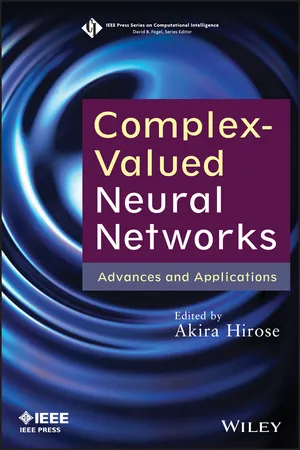
Complex-Valued Neural Networks
Advances and Applications
Akira Hirose, Akira Hirose
- English
- ePUB (mobile friendly)
- Available on iOS & Android
Complex-Valued Neural Networks
Advances and Applications
Akira Hirose, Akira Hirose
About This Book
Presents the latest advances in complex-valued neural networks by demonstrating the theory in a wide range of applications
Complex-valued neural networks is a rapidly developing neural network framework that utilizes complex arithmetic, exhibiting specific characteristics in its learning, self-organizing, and processing dynamics. They are highly suitable for processing complex amplitude, composed of amplitude and phase, which is one of the core concepts in physical systems to deal with electromagnetic, light, sonic/ultrasonic waves as well as quantum waves, namely, electron and superconducting waves. This fact is a critical advantage in practical applications in diverse fields of engineering, where signals are routinely analyzed and processed in time/space, frequency, and phase domains.
Complex-Valued Neural Networks: Advances and Applications covers cutting-edge topics and applications surrounding this timely subject. Demonstrating advanced theories with a wide range of applications, including communication systems, image processing systems, and brain-computer interfaces, this text offers comprehensive coverage of:
- Conventional complex-valued neural networks
- Quaternionic neural networks
- Clifford-algebraic neural networks
Presented by international experts in the field, Complex-Valued Neural Networks: Advances and Applications is ideal for advanced-level computational intelligence theorists, electromagnetic theorists, and mathematicians interested in computational intelligence, artificial intelligence, machine learning theories, and algorithms.
Frequently asked questions
Information
CHAPTER 1
APPLICATION FIELDS AND FUNDAMENTAL MERITS OF COMPLEX-VALUED NEURAL NETWORKS
1.1 INTRODUCTION
1.2 APPLICATIONS OF COMPLEX-VALUED NEURAL NETWORKS
1.2.1 Antenna Design
1.2.2 Estimation of Direction of Arrival and Beamforming
1.2.3 Radar Imaging
1.2.4 Acoustic Signal Processing and Ultrasonic Imaging
1.2.5 Communications Signal Proce...
Table of contents
- Cover
- Half Title page
- Title page
- Copyright page
- Contributors
- Preface
- Chapter 1: Application Fields and Fundamental Merits of Complex-Valued Neural Networks
- Chapter 2: Neural System Learning on Complex-Valued Manifolds
- Chapter 3: N-Dimensional Vector Neuron and Its Application to the N-Bit Parity Problem
- Chapter 4: Learning Algorithms in Complex-Valued Neural Networks using Wirtinger Calculus
- Chapter 5: Quaternionic Neural Networks for Associative Memories
- Chapter 6: Models of Recurrent Clifford Neural Networks and Their Dynamics
- Chapter 7: Meta-Cognitive Complex-Valued Relaxation Network and its Sequential Learning Algorithm
- Chapter 8: Multilayer Feedforward Neural Network with Multi-Valued Neurons for Brain–Computer Interfacing
- Chapter 9: Complex-Valued B-Spline Neural Networks for Modeling and Inverse of Wiener Systems
- Chapter 10: Quaternionic Fuzzy Neural Network for View-Invariant Color Face Image Recognition
- Index